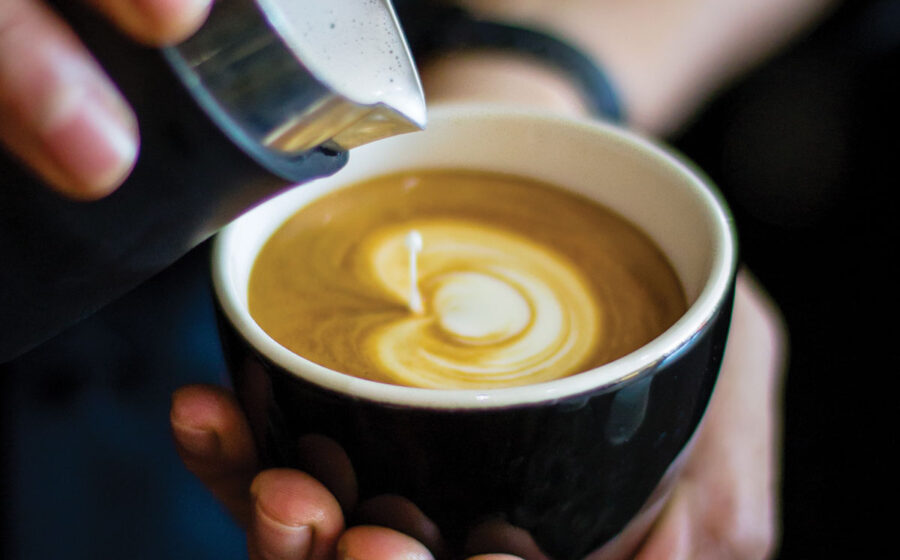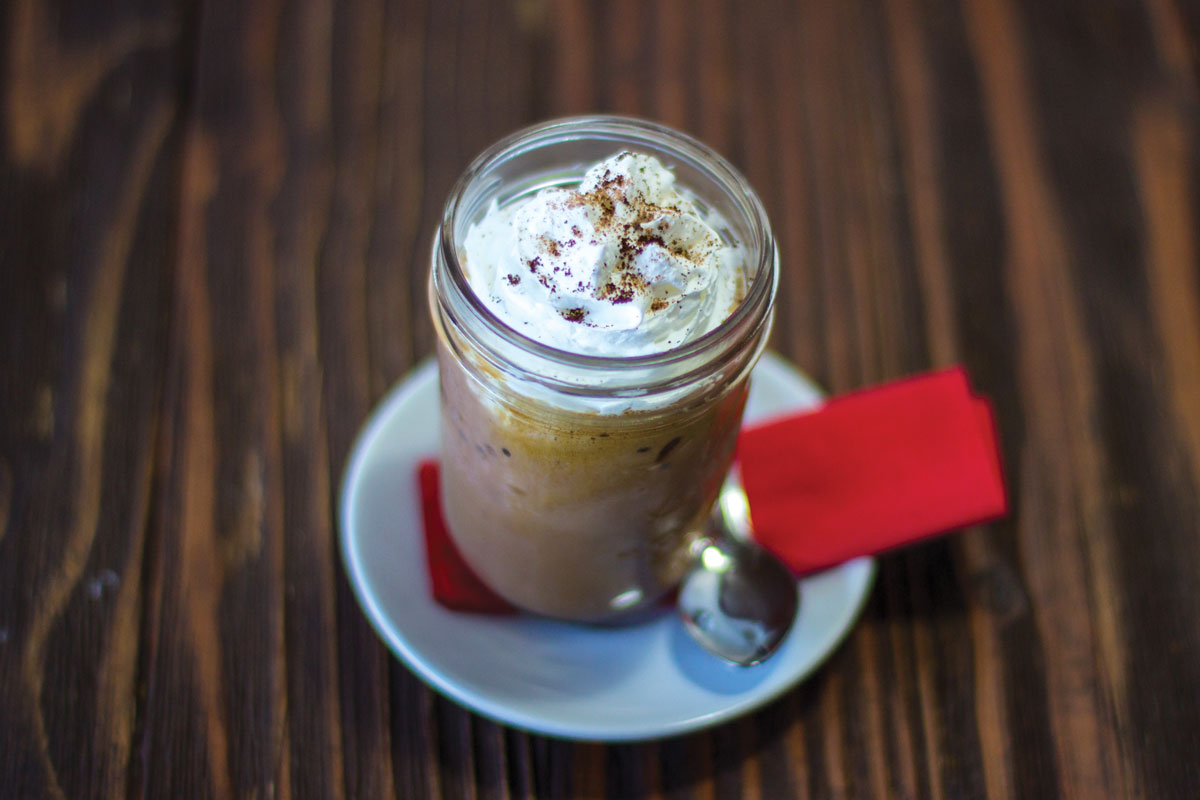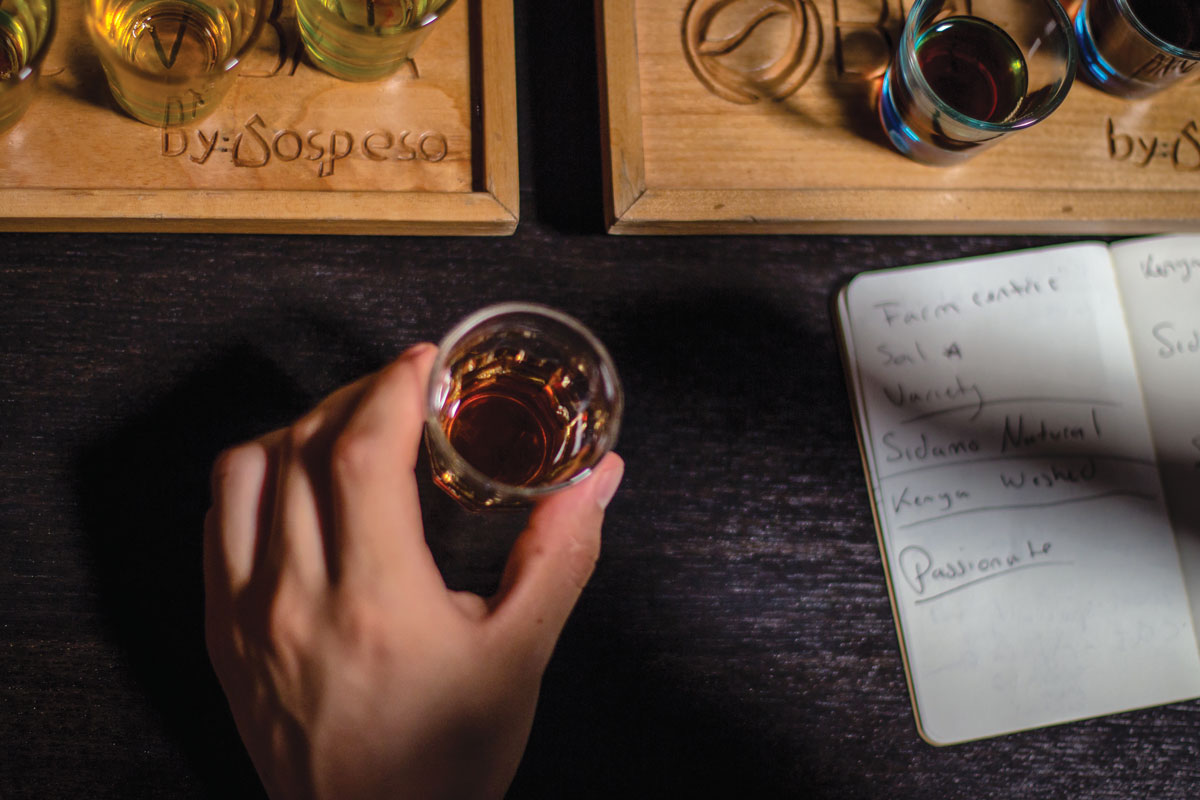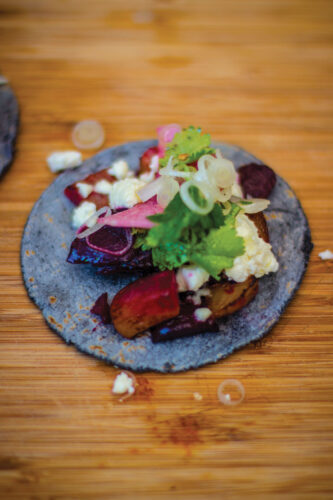[I]t was early on a Tuesday morning, though not too early for a barista, when Jethro Sepulveda picked me up at the massive San Ysidro border crossing that separates San Diego and Tijuana. I had met Jethro recently at a latte art throwdown in San Diego. He was one of a group of Mexican baristas who had come to the competition and showed us that Tijuana had a talented pool of coffee pros. As a coffee professional, I try to constantly learn about new roasters, cafés, and events happening all over. Visits to Los Angeles had fed my appetite for experiencing coffee scenes different from ours in San Diego, where I reside. My excursions and interests had always been pointed north, into the United States. Now I knew I needed to look much closer to home; I needed to look south.
Jethro, a coffee geek, entrepreneur, and architect, offered to show me around some of his city’s roasters and cafés, and without hesitation I jumped at the invitation. As we went into Tijuana, he said he would turn my visit into an extremely caffeinated adventure.
Tijuana and San Diego form a single metropolitan area, sharing a commuter population that works in the US and lives in Tijuana. But the majority of San Diegans are shy about visiting this city. The bad press created by the drug violence that peaked in 2008 still discourages tourism and most Americans’ views of the city are well out-of-date. Even for those who frequent the city, it mostly exists as a nighttime playground. Curiously, this sparked something positive. Local businesses have refocused their energy from pleasing the foreigner’s palate to competing for the Tijuana market through quality and distinctiveness. Personally, this visit allowed me to rediscover Tijuana and better understand its energizing present.
For our first stop, Jethro took me to the outskirts of the bustling Centro, the downtown district of the city. Surrounded by small businesses and behind an unassuming facade is Sur a Norte Coffee Roasters. I stepped inside and was greeted by welcoming faces and a glistening Nuova Simonelli. The neon green walls, covered with wooden pallets, framed their brand new twenty-five kilo roaster made in Veracruz, the country’s epicenter of roaster fabrication. Antonio Guerrero, barista for Sur a Norte, gave me a shot of their Oaxacan. With a nutty flavor and hints of tobacco the shot was deliciously bright. Not only was Antonio passionate and knowledgeable about his product, he was curious. Immediately after I handed him some coffee beans I’d brought with me, he put them in the hopper and started experimenting.
Alex Reyes, owner of Sur a Norte, walked through the door as I finished my espresso. After shaking hands with all his regulars, Alex talked to me about his company and its goals. Sur a Norte is primarily a wholesale coffee roaster, providing beans to restaurants and coffee shops. His selection is Mexico-centric with some organic options. He wants Sur a Norte to provide single-origin coffees from all over Mexico to showcase each region’s unique flavors.
Alex explains that Tijuana’s coffee professionals are active with the SCAA and its Mexican equivalent the AMCCE (Asociación Mexicana de Cafés y Caféterías de Especialidad). This duality gives Tijuana an interesting position. As part of Mexico, it has the perspective of a green coffee producer. At the same time, its proximity to the US gives it access to trends of a consumer nation.
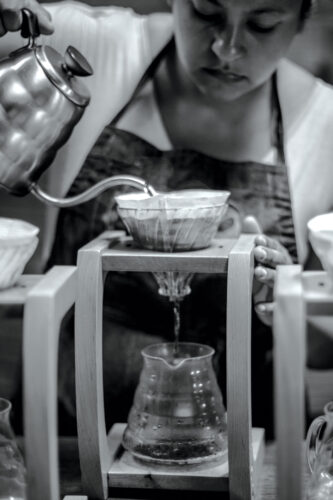
From its inception, the company set out to differentiate itself by providing a drastically different café experience. Their menus do not offer blended drinks or the layered “dry cappuccino.” Instead they focus on quality preparations and feature sought-after, local roasters such as Sur a Norte. They also want to elevate the role of the barista, something evident in their spatial organization. The counter is free of registers and the adjacent seating area has a framed window directly behind the espresso machine, allowing continuous interaction between baristas and customers.
As part of Mexico, Tijuana has the perspective of a green coffee producer. At the same time, its proximity to the US gives it access to trends of a consumer nation.
Located in a working-class neighborhood, this café caters to people from many backgrounds. I saw Miguel, the barista, pour short lattes for the taqueros in the stand across the street and simultaneously greet a group of suited gents. An egalitarian product in a highly stratified society, coffee has certainly made a community space of Das Cortez.
Jethro and I were hungry and decided to have lunch at Verde Crema, one in the new wave of restaurants in the city focused on serving locally sourced ingredients, wine, and beers from microbreweries. Shortly after, we visited Alex Ruiz’ café, La Stazione. The parallels between the culinary hotspot and this remarkable café speak to the progressive food and beverage scenes of Baja California. My lunch included an organic beet taco topped with goat cheese from the nearby Guadalupe Valley, washed down with an Astillero IPA by Agua Mala Brewery. In the same spirit, coffee at La Stazione is all about carefully selected, locally roasted coffee and rustic Mexican ingredients such as piloncillo, a type of raw cane sugar. Even the water cooler, often ignored, is infused with mint and cucumber. These details throughout the space indicate Alex’ culinary proclivities.
A multi-roaster café, La Stazione’s selection contains local roasters from both sides of the border. That day there was coffee from Bird Rock Coffee Roasters, where I work, including a washed Yirgacheffe, an Elida Estate Panama, and a Muthonjo Estate Kenya mindfully made in the brewing method of your choice: AeroPress, V60, or French press. Alex told me that his goal is to showcase a range of flavors from the floral light roasts of Bird Rock to the local Mexican coffee roasted light to medium. He wants his customers to get a feel for the whole flavor spectrum of coffee. The interior is quirky yet polished, with dark wood details contrasting the black marble counters and striped walls. Touches of red in the furniture and porcelain work harmoniously with the stainless steel of their La Marzocco Linea.
Following Alex’ eager suggestion I decided to try a magical concoction called the Pond Bear, named after Tokyo’s influential roaster Bear Pond Espresso. Drawing from their manipulation of texture to create indulgent espresso drinks, Alex makes his creation by layering chocolate ice cream, Oaxacan chocolate, espresso, and homemade whipped cream. The resulting dessert is decadent but somehow not too sweet. The variety of textures creates heaven in your mouth! I left La Stazione with a better understanding of Baja’s culinary direction and its intersection with the coffee world.
[J]ethro and I then relocated to Zona Rio. Unlike the small businesses of the Centro, this district was dominated by high-rises of banks, hospitals, and office spaces. I couldn’t tell if it was all the coffee we had consumed but Jethro looked jittery and very exited. We stopped at a curious looking building; it was Alberto Song’s Caffe Sospeso. The first thing I saw were towering Yama drippers, a brew bar on the left, and an espresso bar to the right. This café is spacious and calm, a place where doctors and bankers take a coffee break.
Alberto is motivated by quality, experimentation, and education. As a member of the Coffee Quality Institute, he understands the factors that affect quality and are later translated in the cupping room. His participation with CQI has taken him to Africa, South America, and Central America. This obsession over quality and traveling to origin began with Alberto’s visits to Mexico’s Chiapas coffee-growing regions in 1997. Now he roasts small batches on a San Franciscan, just behind the brew bar, and origins are rotated every fifteen days.
I had the pleasure to indulge in two different coffees, both brewed with a V60. The coffees were presented in shot glasses set on custom wooden trays, reminiscent of a mezcal tasting flight. I was given a washed Kenya Gatomboya that exhibited a lively acidity with sweet molasses aroma. Also in the tasting flight was a natural Sidamo, with rich and clean notes of blueberry and tangerine. This same Sidamo was also extracted via Yama dripper and sold in a fabulous bottle. This cold-brew blew my mind and palate! It was intoxicatingly blueberry and the sweetness was liquor-like and oh-so-smooth.
In the near future San Diegans will be able to buy Sospeso’s beans and brews without crossing the border when Sospeso becomes the first specialty coffee roaster from Tijuana to expand to San Diego.
Not certain that we could handle more coffee, we drove further into the city for our last stop, Dinastía 12. We parked at a strip-mall across the street from the impressive Las Torres, a pair of twin skyscrapers that dominate they city’s skyline. The café’s interior had a central bar-island layout and modern décor consisting of stainless steel counters and accents of red and black.
Dinastía 12 is a roaster, barista school, wholesale distributor, café, and a significant participant in the Mexican Barista Championships. Last year was a great year for D12. First, Nestor Ramirez, the company’s barista trainer, attained a spot in the top twenty at the Mexican Barista Championships. Nestor was the only Tijuanense in this privileged spot.
At their newly opened location in the nearby Plaza Minarete, Jethro and I were able to watch Gerardo Jara lead a training course for a couple of baristas. The two baristas were extremely engaged and it was clear that Gerardo loves his craft. The various drinks he made for us were impeccably executed and he carried us through the process, dropping great jewels of information along the way. His favorite origin on hand was their natural processed Guerrero. He chose to make four different drinks with it. The espresso was extremely nutty and floral, with hints of rose, a thick body, and pleasant acidity. The V60 was phenomenal; it carried sweet citrus notes (much like a kumquat) making it my favorite of the four drinks. I was also served a beautiful cappuccino, made on a La Marzocco Strada. Lastly, Gerardo made a segafredo. This refreshing drink is an iced americano agitated in a cocktail shaker and poured over ice.
Looking to avoid the evening foot traffic at the border crossing, I headed back home. Wide awake and waiting in line, I had time to reflect on the visit. Although every establishment had its own personality and niche there were certain similaries. Here I found people who took pride in their craft, knew coffee deeply, and wanted to provide their community outstanding coffee, especially sensational Mexican coffee. Tijuana isn’t an emerging coffee city. It’s an established coffee city; we were just looking elsewhere when it rose up.
—Pablo Lara is a barista and coffee writer based in San Diego, California. Photos by Angel Breton.



